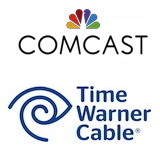How One Local Cable Monopoly Can Compete With Another
 Last Friday brought reports that Comcast had begun seeking counsel on the finer points of it possibly buying Time Warner Cable.
Last Friday brought reports that Comcast had begun seeking counsel on the finer points of it possibly buying Time Warner Cable.
Comcast is the biggest cable operator in the United States and TWC is the second-biggest. And yet you could forgive an individual subscriber for saying “who cares?” — in most markets, one cable firm has a 100 percent share of the market for cable TV.
Giant firms like Comcast and TWC were built on locally-granted monopolies, and the 1990s dream of small “overbuilder” cable franchises providing direct competition to incumbents like Comcast and TWC dimmed and died years ago as the expansions of firms like RCN slowed and stopped.
Cable still has to contend with satellite and fiber-optic services, plus the more existential threat of cord-cutters switching to Internet streaming and over-the-air broadcasts. In the third quarter, cable operators lost 687,000 subscribers, leaving the subscription-TV business down 113,000 after gains by cable rivals.
But Comcast engulfing TWC — or carving it up with another cable firm, possible Charter Communications — would not add or subtract pay-TV choices in any of those firms’ markets.
Indeed, the big cable operators not only seem resolutely uninterested in poaching on each other’s territory, they’re sufficiently comfortable with one another’s company to give everybody else’s customers free access to their own WiFi.
But even companies that face no direct threat from each other can still take different paths in the market that, in turn, open or close other possibilities.
Price is the obvious but least interesting area — thanks in part to the opacity wrapped around cable rates by expiring promotional offers, non-overlapping channel lineups, and bundled “triple-play” offers that combine TV with Internet access and what’s typically gold-plated phone service.
Even so, it’s interesting to see that Comcast offers a cheaper “Digital Economy” bundle without sports channels — allowing viewers uninterested in paying ever-higher prices for sports programming to opt out of them.
Comcast also undercuts TWC’s prices for equipment, based on searches at one sample address in Arlington and another in Manhattan. The difference is only 30 cents a month for an HD tuner, but $5.25 for a high-def DVR.
(On that note: Why do any cable operators still present standard-definition tuners as the default equipment choice? Is anybody still fooled by their lower prices?)
Openness to third-party tuning and recording hardware is a bigger, more significant difference. Want to use your own TiVo instead? Comcast will give you a CableCard for free, while TWC will charge you $2.50 a month for it.
TWC and Cablevision also rushed to encrypt digital “QAM” transmissions of local, public, and government channels, leaving customers stuck with having to add an extra converter box for TVs used to watch only those basic channels–and in some cases paying extra for an HD converter.
But at the same time, TWC has done better than most at letting users watch the channels they pay for on their TVs without a cable box or a CableCard device — by virtue of making its feed available as an online video stream through such devices as Roku players and the Xbox 360.
In contrast, Comcast may be advertising the ability get HBO with an Internet-only subscription, but HBO’s site shows it has yet to whitelist Roku players or Samsung Smart TVs for HBO Go access.
Cable operators can act the least alike when it comes time to negotiate retransmission fees with content. TWC and Cablevision, for instance, have been much more willing to kick channels off their systems when those talks stall out.
But as cable operators increasingly get into the content business themselves — either through in-house programming, pricey regional-sports-network deals such as TWC’s role in the Los Angeles Dodgers’ new SportsNet LA, or multi-billion-dollar transactions like Comcast’s takeover of NBC Universal — “retrans” fights increasingly look like family feuds.
And if anything will make regulators put down the remote and pay attention, the risk of abuse of that growing market concentration can and should.








